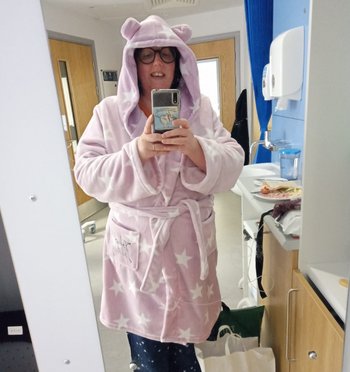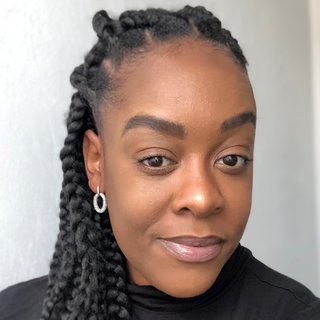I'm so grateful for my precious donor cells
For Louise, a stem cell transplant was the best option to treat myelofibrosis (MF). She describes what it’s like to have the treatment and how she is now.

I was diagnosed with myelofibrosis in 2021. It took two years to get to that point and I was very unwell by the time I got the diagnosis. In fact I was told that I needed a stem cell transplant within the next 12 months.
It was a struggle to get diagnosed correctly. I ended up making a complaint about it last year and that’s been resolved, although I still feel frustrated and angry about it. But the consultant who took over my care is lovely, and I have had a good experience with my treatment team.
I’m now two years post transplant, and the myelofibrosis is gone, although I am now living with some long-term effects."
My symptoms
Back in 2019, blood tests showed I had low platelets. No one knew why, but it was causing a lot of bleeding. I have always had nosebleeds, but these were horrendous, and my periods were dramatically different. Blood was pouring from my gums.
I felt exhausted and I knew there was something wrong. Later, my spleen became swollen which meant it was hard to eat and I felt very sick every time I bent over.
Getting the news
When I was finally told I had myelofibrosis (MF), I had never heard of it. I had heard of a stem cell transplant, because ironically, I was on the register to be a donor. So I knew it was a serious thing, but at that point I had no idea what was serious about it.
The MF was progressing quickly, and it was a rare kind called “triple negative” MF. I don’t have the usual faulty genes that cause MF. For me, there’s a weird sub gene involved. The consultant said that there was no time for dawdling, the transplant was needed within 12 months.
I didn’t really understand the urgency of it, but he said if the MF progressed too far, I wouldn’t be a candidate for transplant anymore."
I didn’t have any close family who could potentially donate their stem cells. So the search began for an unrelated donor on the UK and international registers. In the meantime, I was put on a drug called ruxolitinib to help with my symptoms.
Waiting for a donor
I wasn’t worried about the actual stem cell transplant at that time, because what was the point? They might not even find me a donor.
But the waiting was hard. They book you a clinic appointment in preparation, but if they haven’t found a donor by that time, they ring you to say there’s no need to come in.
I felt like a dead man walking. But after 5 months, they told me they’d found a match, a 31-year-old man in Germany."
My transplant team gave me the Blood Cancer UK booklet about stem cell transplants, including what happens, what to bring to hospital and potential problems that could arise.
I like to have information. I want to know it all. And then I can deal with it. I don't like surprises.
Having the transplant
I was in hospital for a total of 7 weeks. I had intensive chemotherapy by IV drip 20 hours a day for seven days, with a break of four hours in the early hours of the morning.
I didn’t get much sleep, because a bleep went when the IV bag was finished, and I had to buzz the nurse to change it. People were also coming in regularly to do checks and blood tests.

I spent 7 weeks in hospital. Here I am wearing my new dressing gown with ears.
I did have side effects. I was very nauseous, so I had anti-sickness drugs through a syringe driver and some tablets as well."
I had a lot of pain which was managed with IV paracetamol and oral morphine. Some of this was because I had to stop taking the ruxolitinib suddenly. There was no tapering off, so I had rebound symptoms that had been controlled by the ruxolitinib.
On the eighth day I had full body radiotherapy.
On the day of the actual transplant, they brought the donor cells out of the freezer and hooked the bag up to an IV after triple checking the codes to make sure I was getting the right cells.
The cells were dripped in very slowly, with a nurse closely monitoring me the whole time. There has to be someone there just in case you react to the new cells, they’re very careful. The drip smells weirdly like popcorn.
Waiting for the graft
Then it was just waiting for the graft to happen - for the new stem cells to start making blood cells. In the meantime, I needed transfusions of whole blood or platelets because I had no blood of my own.
That was a challenging time. I was very poorly, but my clinical team were exceptional, and the healthcare support workers got me through some difficult days.
I remember sitting there thinking, 'I’m never going to start making my own blood!' It was a bit terrifying."
You’re looking for the blood counts to change slightly and for me that finally happened on day 19.
After that, my blood counts started to recover rapidly, and now, my hospital team say that they have never seen anyone with such fabulous blood!

This is a wolpertinger that was made for me - it's a chimera with the body of a rabbit, wings, antlers and fangs!
My wolpertinger
When the donor cells start working in a new body, it’s called chimerism. A chimera is an animal made of different parts, and that’s how I think of my precious donor cells – as a chimera called a wolpertinger, a rabbit with wings and antlers. It’s from German folklore, which seems appropriate in the circumstances!
One odd thing is because my donor has a different blood type from me, my blood type has now changed.
Some lasting effects
So my blood is perfectly fine, but I do have some ongoing problems from the treatment. I have very sensitive skin caused by having total body irradiation (radiotherapy) which I had before the transplant, but not everyone has that.
I got an infection in my Hickman line which may in turn have caused some blood clots in my leg. I’m seeing a vascular specialist about that, and the chronic pain service is helping me to manage the pain I have for various reasons. I work part-time now, because I still have chronic fatigue. I’m also going through an early menopause.
So things aren’t exactly back to how they were before. My clinical team continue to monitor me closely and I’m currently seen in clinic every four months.
As I’m two years post transplant, I’m the equivalent of a two-year-old in immune system terms. So this year I’ll be 3 years young as well as 47 years old."
It’s been a very long and slow recovery, which has been a hard lesson, but I am so very grateful to my donor, as without him I wouldn’t be here now to tell my story.
Not everyone is suitable for a stem cell transplant because it is an intensive treatment and your hospital team must weight the benefits against the risks.
Louise helped us create our myelofibrosis booklet, including understanding myelofibrosis, treatments and living well. Order your free copy.



